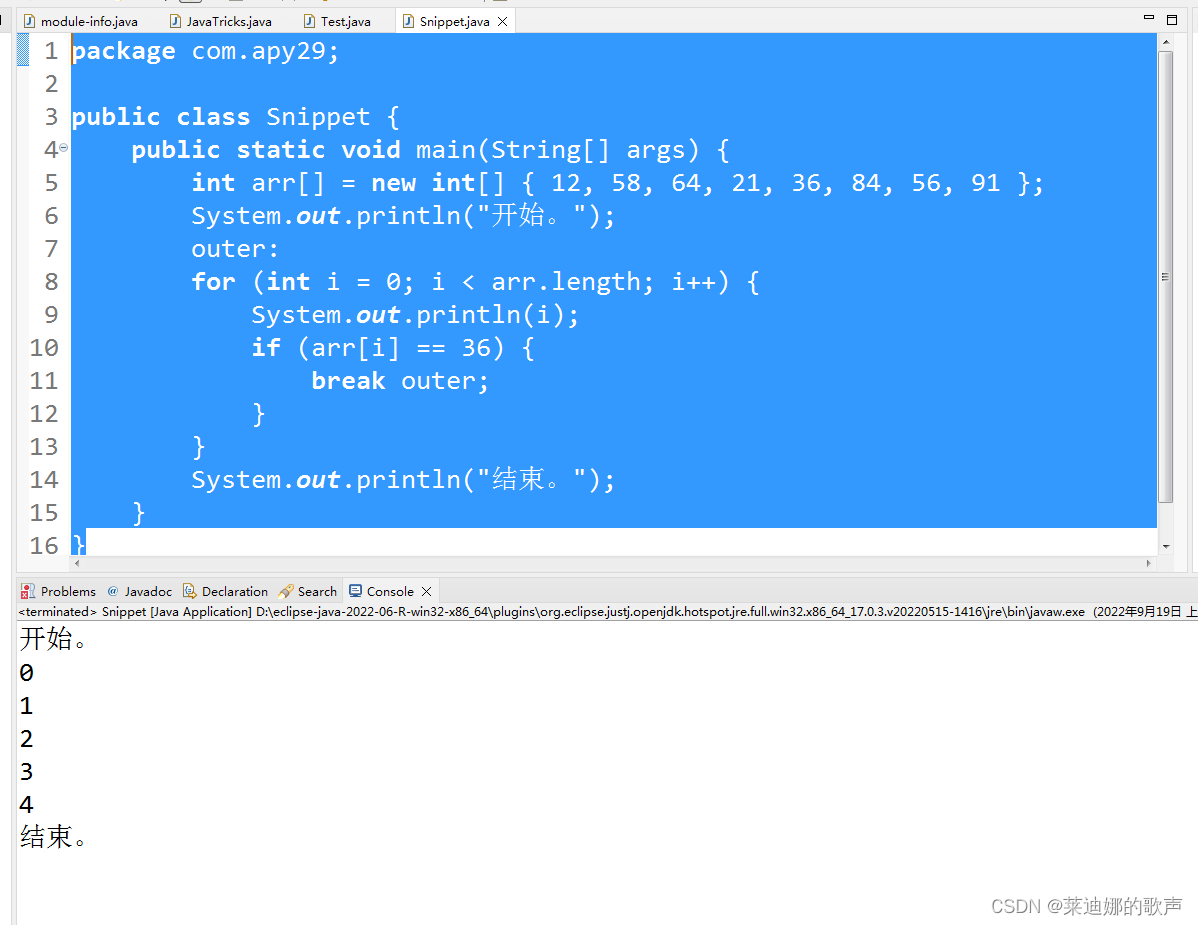一、标签循环:
package com.apy29;
public class Snippet {
public static void main(String[] args) {
int arr[] = new int[] { 12, 58, 64, 21, 36, 84, 56, 91 };
System.out.println("开始。");
outer:
for (int i = 0; i < arr.length; i++) {
System.out.println(i);
if (arr[i] == 36) {
break outer;
}
}
System.out.println("结束。");
}
}
二、Class 类的定义可以放在任何地方:
package com.apy29;
class Test {
public static void main(String[] args) {
class InnerClass {
void way() {
System.out.println("way");
}
}
new InnerClass().way();
}
}
三、有一个对象叫做Void:
Void (Java Platform SE 7 ) 常见的用例是不需要返回值的泛型方法
Modifier and Type |
Field and Description |
| The Class object representing the pseudo-type corresponding to the keyword void. |
四、new ArrayList<Object>() 允许你在没有Arrays. asList的情况下声明和初始化
private static List<String> places = new ArrayList<String>() {
{
add("x");
add("y");
}
};五、静态方法可以是通用的:
package com.apy29;
class Test {
static <T> T identity(T t) {
return t;
}
public static void main(String[] args) {
String s = Test.<String> identity("Hi");
System.out.print(s);
}
}
六、你可以提供可变长度的参数:
package com.apy29;
public class Snippet2 {
void example(String... strings) {
for (int i = 0; i < strings.length; i++) {
String string = strings[i];
System.out.println(string);
}
};
public static void main(String[] args) {
String[] strings = new String[] { "hello world", "你好,世界。", "我来自新世界。" };
new Snippet2().example(strings);
}
}七、泛型类型参数中的联合:
package com.apy29;
public class Baz<T extends Foo & Bar> {
}
interface Foo {
}
interface Bar {
}八、同时定义、实例化和调用所有内容:
package com.apy29;
public class Snippet {
public static void main(String[] args) {
new Object() {
void hi(String in) {
System.out.println(in);
}
}.hi("weird");
}
}九、将java int 数组转化为 Integer 数组对象:
package com.apy29;
import java.util.ArrayList;
import java.util.Arrays;
import java.util.List;
import java.util.stream.IntStream;
import java.util.stream.Stream;
public class IntArrConvertIntegerList {
private static List<String> places = new ArrayList<String>() {
{
add("x");
add("y");
}
};
/**
* 将arrint 转化为 java Integer数组对象
*
*/
public void intArrConvertIntegerList(int[] arrint) {
IntStream stream = Arrays.stream(arrint);
Stream<Integer> boxed = stream.boxed();
Integer[] array = boxed.toArray(Integer[]::new);
for (int i = 0; i < array.length; i++) {
Integer integer = array[i];
System.out.println(integer);
}
}
public static void main(String[] args) {
Integer arr[] = new Integer[] { 12, 58, 64, 21, 36, 84, 56, 91 };
int arrint[] = new int[] { 12, 58, 64, 21, 36, 84, 56, 91 };
// Arrays.asList() 方式将数组转化为List
List<Integer> asList = Arrays.asList(arr);
for (int i = 0; i < asList.size(); i++) {
int j = asList.get(i);
System.out.println(j);
}
// new ArrayList<String>(){add("x");add("y")} 直接定义
for (int i = 0; i < places.size(); i++) {
System.out.println(places.get(i));
}
// 转化示例
new IntArrConvertIntegerList().intArrConvertIntegerList(arrint);
}
}这是我在使用Java的过程中总结的一些Java编程的技巧,相信会对你有帮助,后续我会继续探索并带给大家更多的Java知识点。
本文含有隐藏内容,请 开通VIP 后查看